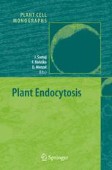Search
Search Results
-
SNAREs in Plant Endocytosis and the Post-Golgi Traffic
In eukaryotic cells, the transport vesicles carry various cargo proteins from a donor compartment to a target compartment, and discharge the cargo...
-
Plant Vacuoles: from Biogenesis to Function
The plant vacuolar system is far more complex than originally expected and multiple sorting pathways leading to various types of vacuoles can be...
-
Endocytosis in Guard Cells
Stomatal movement requires large and repetitive changes to cell volume and consequently surface area. These alterations in surface area are...
-
Endocytosis and Actomyosin Cytoskeleton
Mutual interactions between actin and endocytic assembly machineries are essential for successful clathrin-mediated endocytosis in yeast and...
-
Endocytosis and Membrane Recycling in Pollen Tubes
In plants, tip-growing cells are an ideal system to investigate signal transduction mechanisms and, among these, pollen tubes are one of the...
-
Plant Prevacuolar Compartments and Endocytosis
Prevacuolar compartments (PVCs) are membrane-bound organelles mediating protein traffic from both Golgi and plasma membrane to vacuoles in...
-
Importance of Cytoskeleton and Cell Wall in Somatic Embryogenesis
Both the cytoskeleton composed of microtubules and actin microfilaments as well as cell wall components such as arabinogalactan proteins and...
-
Ions and Pollen Tube Growth
Ions play a crucial role in the control of pollen tube growth. In this review we focus on four that seem especially important: calcium (Ca...
-
Comparative Analysis of Biological Models used in the Study of Pollen Tube Growth
The mechanisms of pollen tube growth have been studied in a wide variety of plant species. Since the 1990s, with the explosion of molecular...
-
Gametic Embryogenesis in Triticum: a Study of Some Critical Factors in Haploid (Microspore) Embryogenesis
This review of embryogenesis from microspores in two types of wheat examines the influences of various procedures used to induce and produce...
-
Chemical Modifications of Biomolecules by Oxidants
There is strong evidence in support of the oxidation of biomolecules during normal physiology and under conditions of environmental or pathological...
-
Molecular responses of higher plants to dehydration
A massive amount of data has been accumulating on the molecular responses of plants to water deficit. In plants, dehydration activates a protective...
-
Heavy metal signalling in plants: linking cellular and organismic responses
Heavy metals are required in plants as essential micronutrients or act as toxic compounds. How do plants perceive heavy metals and which signalling...
-
Introduction
Everywhere in the world, environmental stresses represent the most limiting factors for agricultural productivity. Besides plant-specific endogenous...
-
Molecular genetics of genotoxic stress signalling in plants
Cells are under constant threat by endogenous and exogenous factors affecting DNA integrity. In response, complex signalling networks are activated...
-
Oxidative stress signalling
Oxidative stress arises from an imbalance in the generation and removal of reactive oxygen species (ROS) within cells. ROS are produced during...
-
DNA Repair: Mechanisms and Measurements
The early findings that significant amounts of modifications are induced to the cellular DNA both spontaneously and as a consequence of metabolism...
-
Mitochondrial Free Radical Production, Antioxidant Defenses and Cell Signaling
Mitochondria were classically recognized as the organelles that produce the energy required to drive the endergonic processes of cell life, but now...
-
Protein Repair and Degradation
Protein oxidation is one of the important processes taking place during oxidative stress. Numerous amino acids can be modified within proteins...
-
Superoxide Dismutases and Catalase
Superoxide dismutases (SODs) and catalase represent the primary enzymatic defense against reactive oxygen species. Both enzymes are present in...
